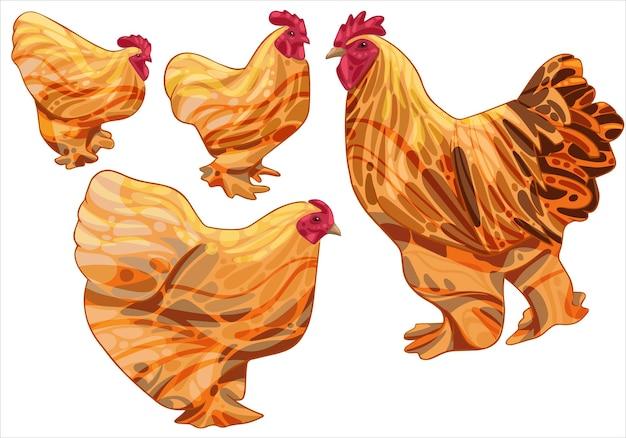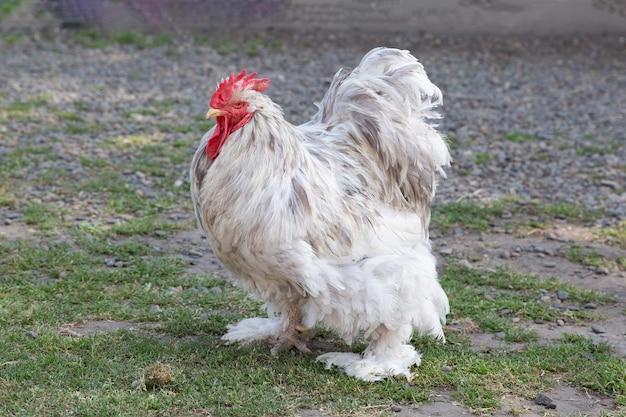Cochin chickens, with their fluffy feathered appearance and gentle demeanor, are a popular choice among poultry enthusiasts. However, determining the gender of these charming birds can be a bit tricky, especially for beginners. If you’ve ever wondered how to tell a Cochin rooster from a hen, you’ve come to the right place.
In this comprehensive guide, we’ll delve into the fascinating world of Cochin chickens and explore various methods to help you identify their gender. From examining physical characteristics to understanding their behavior, we’ll cover it all. So whether you’re a backyard chicken keeper or simply curious about these feathered friends, keep reading to learn the secrets of telling a Cochin rooster from a hen.
But before we proceed, let’s explore some interesting facts about Cochin chickens, their origins, and other intriguing details. By the end of this blog post, you’ll have all the knowledge you need to confidently determine the gender of your Cochin flock. So let’s jump right in!
How to Differentiate Between a Cochin Rooster and Hen
If you’re new to raising Chickens, telling apart a Cochin rooster from a hen might seem like a daunting task. These fluffy creatures can look so similar at first glance. But fear not, my fellow chicken enthusiasts! In this guide, I’ll share some foolproof tips to help you determine whether you’re dealing with a mighty Cochin rooster or a lovely Cochin hen.
The Feathers Never Lie
When it comes to identifying a Cochin’s gender, a closer look at their feathers can give you some valuable indicators. Now, I don’t mean examining them under a microscope or hiring a team of scientists. I’m simply talking about noticing some key differences that can easily be spotted by the naked eye.
1. Hackle Feathers
Take a gander at the feathers around the neck area, known as hackle feathers. In roosters, these feathers tend to be particularly long and pointy, as if they’re trying to say, “Look at me! I’m a big, strong rooster!” On the other hand, in hens, these feathers are shorter and more rounded, giving them a dainty, elegant appearance.
2. Tail Feathers
Ah, the tail feathers! They can be quite telling when it comes to separating the males from the females. Roosters, being the attention-seekers they are, proudly flaunt their impressive tail feathers. These feathers are often curved and showy, standing tall and making a statement. On the contrary, hens have more discreet tail feathers that are generally less flamboyant. They prefer to let their personalities shine through in other ways.
Size Matters… Sometimes
While it’s not a foolproof method, size can sometimes help you distinguish between a Cochin rooster and hen. Now, don’t go fetching a ruler just yet. We’re not talking about measuring their height or wingspan. Instead, we’re referring to their overall build.
3. Body Size
In general, Cochin roosters tend to be larger in size compared to their female counterparts. A rooster may sport a stockier build and have a more dominant presence. On the other hand, hens might appear more delicate and streamlined, proving that big things can indeed come in small packages.
Crow, or Not to Crow? That is the Question
Ah, the crow. The unmistakable sound that wakes you up at the crack of dawn and, sometimes, makes your neighbors wish you had a quieter hobby. While this might not be the most scientific way to determine a Cochin’s gender, it can definitely give you a clue if you’re lucky enough to hear it.
4. The Cock-a-doodle-doo
Well, ladies and gentlemen, hens don’t possess the ability to crow. So if you wake up one fine morning to a resounding “cock-a-doodle-doo” echoing through your coop, you can safely assume that your Cochin is a proud, strapping rooster. However, if all you hear is blissful silence or soft clucking, it’s likely you’ve got yourself a lovely hen.
Now that you’re armed with these expert tips, telling a Cochin rooster from a hen should no longer be a mystery. Remember to observe the feathers, pay attention to body size, and listen for that distinctive crow. With practice, you’ll become a chicken gender-guessing pro in no time. So, go forth and impress your fellow chicken enthusiasts with your newfound knowledge! May your Cochin flock thrive, whether it’s filled with roosters, hens, or a delightful mix of both.
Disclaimer: We cannot be held responsible for any arguments that may arise among chickens due to misgendering.
FAQ: How To Tell A Cochin Rooster From A Hen
Introduction
If you’ve ever found yourself wondering how to tell a Cochin rooster from a hen, you’re not alone. These fluffy birds have captured the hearts of many chicken enthusiasts with their unique appearance and friendly demeanor. But distinguishing between the males and females can sometimes be a challenge. Fear not! In this comprehensive FAQ guide, we’ll answer all your burning questions about Cochin chickens and help you uncover the secret to telling a Cochin rooster from a hen.
What do Cochin eggs look like
Cochin eggs are nothing short of delightful. Their eggs are typically light to medium brown, with a hint of warmth in their color. So, when you find a cozy, cocoa-colored egg in your nest, you can be almost certain it’s from your beloved Cochin hen!
What is the origin of the Cochin chicken
Cochin chickens have a storied history that dates back to their origins in China. These feathery wonders were brought to the United States in the mid-19th century and quickly became a favorite among breeders and chicken enthusiasts alike.
Are Cochin chickens cold hardy
Absolutely! Cochins are known for their incredibly fluffy feathers, which provide excellent insulation during chilly weather. They have a dense plumage that keeps them cozy and warm, even in colder climates. So, rest assured, your Cochin chickens will be perfectly comfortable strutting their stuff in the snow.
Are Cochins good mothers
Yes, indeed! Cochins are renowned for their excellent maternal instincts. They are incredibly nurturing and protective, making them ideal mothers for their fluffy little chicks. You can trust a Cochin hen to be a devoted and caring caretaker for her brood.
What color are Cochin chickens
Cochin chickens come in a variety of breathtaking colors. From the classic white to stunning buff, to beautiful shades of black, blue, and splash. Whatever your preferred color palette, there’s a Cochin chicken to match your aesthetic. These chickens are like walking works of art!
Are Cochin chickens loud
While every chicken has its own unique voice, Cochin chickens are generally on the quieter side. They tend to produce a soft and gentle clucking sound rather than ear-piercing squawks. So, if you’re looking for a calming presence in your flock, Cochin chickens make the perfect choice.
Do Cochin hens have wattles
Absolutely! Cochin hens do have wattles, those fleshy lobes that hang down from their chins. These wattles may not be as prominent as those of roosters, but they’re still there, adding a touch of charm to these lovely ladies.
What does a Cochin hen look like
Cochin hens are simply stunning. They have a rounded and compact body covered in an abundance of soft, fluffy feathers. With their feathered legs and feathery feet, they almost appear to be wearing fancy feathered boots. These hens exude an elegance that is hard to resist!
What is a Barred Cochin
A Barred Cochin is a striking variety of the Cochin breed. These chickens have a unique barred pattern, with alternating bands of dark and light feathers running across their bodies. They’re like little walking monochromatic art pieces, adding a touch of sophistication to any flock.
Do female chickens have red combs
In general, female chickens’ combs tend to be smaller and less pronounced than their male counterparts. While some breeds may have combs that are redder in color, it’s not exclusive to females. So, remember, appearances can be deceiving when it comes to combs!
How many types of Cochin chickens are there
Cochin chickens come in various types, or should we say “feathery flavors.” From the ever-popular Buff Cochin to the majestic Black, Blue, Splash, and White varieties, there’s a Cochin chicken type for every poultry enthusiast. Each type has its own unique beauty, making it challenging to pick just one favorite!
At what age can you tell if a chicken is a rooster
Determining the gender of a chicken can be like trying to solve a cryptic puzzle. However, if you observe your Cochin closely, you can start noticing gender-specific characteristics as early as six to eight weeks of age. Roosters tend to develop larger combs and wattles and exhibit more assertive behaviors compared to their female counterparts.
What does a Buff Cochin look like
Ah, the stunning Buff Cochin. These chickens have luscious feathers that range from a warm, golden buff to a creamy beige. With their beautifully feathered legs and a gentle aura, Buff Cochins are like walking rays of sunshine in your backyard. They’re sure to brighten up your flock and your day.
How do I identify a rooster
When it comes to identifying roosters, there are a few telltale signs to look out for. Keep an eye on their comb and wattles; roosters often have larger and more vibrant ones compared to hens. Additionally, roosters tend to show off more prominent, pointed saddle feathers on their backs as they mature. So, keep a keen eye on these subtle clues to discover who’s the cock of the walk!
How can you tell if a 12-week-old chicken is a rooster
At 12 weeks old, roosters may start exhibiting some early signs of masculinity. Look for larger combs and wattles compared to their flock mates. Additionally, keep an ear out for any vocal bragging sessions as roosters tend to find their voice during this developmental stage. Remember, it’s all part of their journey to roosterhood!
Is a Cochin a bantam
Yes, indeed! Cochins come in both standard and bantam sizes. The bantam Cochins are miniature versions of their standard-sized counterparts, packing all the cuteness into a more compact package. Bantam Cochins make an excellent choice for those who want feathered friends with a smaller footprint.
What color egg does a Cochin lay
Cochin hens usually lay brown eggs, just like the majority of chicken breeds. They may not lay eggs as large or frequently as some of their egg-laying-focused peers, but their fluffy charm and sweet nature more than make up for it. So, be prepared for a more “boutique-sized” egg when you gather eggs from your Cochin hens.
How do you tell if a chick is a boy or girl
Determining the gender of a chick can be quite the guessing game. However, keen observation can reveal some subtle hints. Female chicks tend to feather out faster than their male counterparts, while males may show a faster growth rate and longer, thicker leg feathers early on. You might not know for sure until they’re a bit older, but the journey of discovery is all part of the fun!
Now that you have the knowledge to distinguish your fluffy Cochin roosters from hens, you can marvel at their fluffy beauty and enjoy their engaging personalities. Cochins are truly a remarkable breed, and by cracking the code to their gender identification, you’re one step closer to becoming a true Cochin aficionado!
So, go forth and proudly watch over your flock, knowing that you possess the wisdom to tell a Cochin rooster from a hen. Happy chicken keeping!

